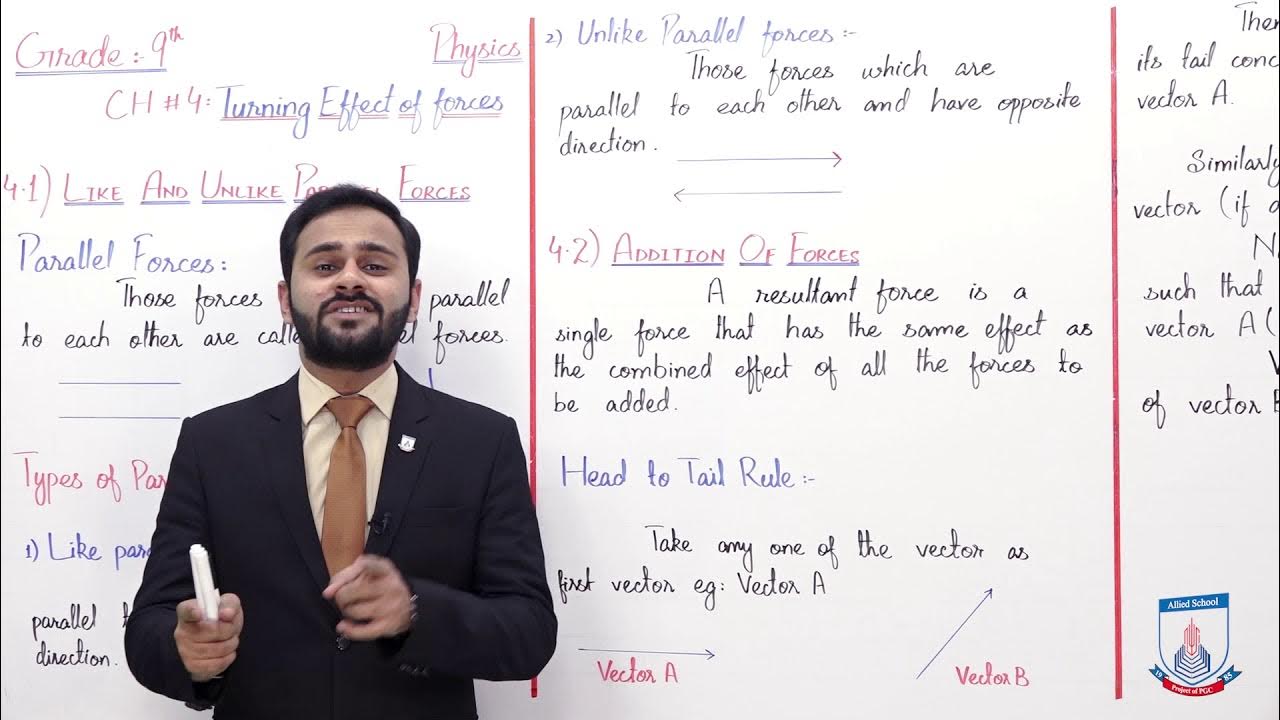GCSE Physics - How Moments Work - Spanners and Seesaws
Summary
TLDRThis video explains the concept of moments, the turning effect of a force around a pivot, using practical examples like spanners and seesaws. It demonstrates how the size of a moment depends on both the force applied and its perpendicular distance from the pivot, showing why longer spanners make tasks easier and how forces balance on a seesaw. Step-by-step calculations illustrate how to compute moments, adjust forces for different distances, and achieve equilibrium. The video also clarifies clockwise and anticlockwise moments, helping viewers understand how multiple forces interact to create rotation or balance in real-world scenarios.
Takeaways
- 😀 A moment is the rotational or turning effect of a force, such as how a spanner turns when force is applied at its end.
- 😀 The pivot is the central point around which rotation occurs when force is applied to an object like a spanner.
- 😀 To calculate the moment, use the equation: Moment = Force × Perpendicular Distance from the pivot.
- 😀 To maximize the moment, apply a larger force at a greater distance from the pivot.
- 😀 The perpendicular distance is crucial, as it must be measured at a right angle to the direction of the applied force.
- 😀 When applying force at an angle other than 90 degrees, the perpendicular distance decreases, and so does the moment.
- 😀 To calculate the moment, ensure that distances are in meters, not centimeters, for correct SI unit consistency.
- 😀 The equation can be rearranged to find the required force if you know the moment and distance.
- 😀 The moment produced on a seesaw depends on both the force and the distance from the pivot, affecting balance.
- 😀 A seesaw will balance when the clockwise and anticlockwise moments are equal. If the moments are not equal, the seesaw will tilt.
- 😀 To balance a seesaw with forces of different magnitudes, calculate the required distance for the opposite force to create an equal moment.
Q & A
What is a moment in physics?
-A moment is the rotational or turning effect of a force applied around a pivot point. It determines how strongly an object will rotate rather than move linearly.
What is the formula used to calculate a moment?
-The formula for calculating a moment is Moment = Force × Perpendicular Distance, where the perpendicular distance is measured at a right angle to the force.
Why is perpendicular distance important when calculating a moment?
-Perpendicular distance is important because only the component of the force that is at right angles to the lever arm contributes to rotation. Any angled force reduces the effective moment.
How does using a longer spanner affect the moment generated?
-Using a longer spanner increases the perpendicular distance from the pivot, which increases the moment for the same applied force, making it easier to turn a nut.
If you apply an 80 N force 0.2 meters from the pivot, what is the moment generated?
-The moment is calculated as 80 N × 0.2 m = 16 Newton meters (Nm).
How much force is needed to generate the same 16 Nm moment if applied 0.1 meters from the pivot?
-Force = Moment ÷ Distance, so 16 Nm ÷ 0.1 m = 160 N. A larger force is required when the distance from the pivot is smaller.
What is the difference between clockwise and anticlockwise moments?
-Clockwise moments rotate an object in the clockwise direction relative to the pivot, while anticlockwise moments rotate it in the opposite direction. The net effect depends on the balance of both.
How can multiple moments act on the same object?
-Multiple moments can act on the same object simultaneously, each with its own magnitude and direction (clockwise or anticlockwise). The overall movement depends on the sum of these moments.
In a seesaw example, how do you calculate the distance needed to balance an 800 N force against a 1200 Nm clockwise moment?
-Distance = Moment ÷ Force, so 1200 Nm ÷ 800 N = 1.5 meters. The force must be applied 1.5 meters from the pivot to balance the seesaw.
What happens if the clockwise and anticlockwise moments on a seesaw are equal?
-If the moments are equal, the seesaw will not move because the rotational effects cancel each other out, achieving equilibrium.
Why do objects like spanners or seesaws illustrate the concept of moments effectively?
-Spanners and seesaws clearly demonstrate how force applied at different distances from a pivot affects rotation, making the abstract concept of moments tangible and easy to visualize.
Outlines

هذا القسم متوفر فقط للمشتركين. يرجى الترقية للوصول إلى هذه الميزة.
قم بالترقية الآنMindmap

هذا القسم متوفر فقط للمشتركين. يرجى الترقية للوصول إلى هذه الميزة.
قم بالترقية الآنKeywords

هذا القسم متوفر فقط للمشتركين. يرجى الترقية للوصول إلى هذه الميزة.
قم بالترقية الآنHighlights

هذا القسم متوفر فقط للمشتركين. يرجى الترقية للوصول إلى هذه الميزة.
قم بالترقية الآنTranscripts

هذا القسم متوفر فقط للمشتركين. يرجى الترقية للوصول إلى هذه الميزة.
قم بالترقية الآنتصفح المزيد من مقاطع الفيديو ذات الصلة

Hebelgesetze – Wie funktioniert ein Nussknacker?

Understanding How Torque Works

Class 9 - Physics - Chapter 4 - Lecture 1 - 4.1 & 4.2 - Allied Schools

Torque, Basic Introduction, Lever Arm, Moment of Force, Simple Machines & Mechanical Advantage

TORQUE OU MOMENTO DE UMA FORÇA | RESUMO DE FÍSICA PARA O ENCCEJA

Soal 1 | Kisi-kisi UAS Fisdas 1B 2024
5.0 / 5 (0 votes)
